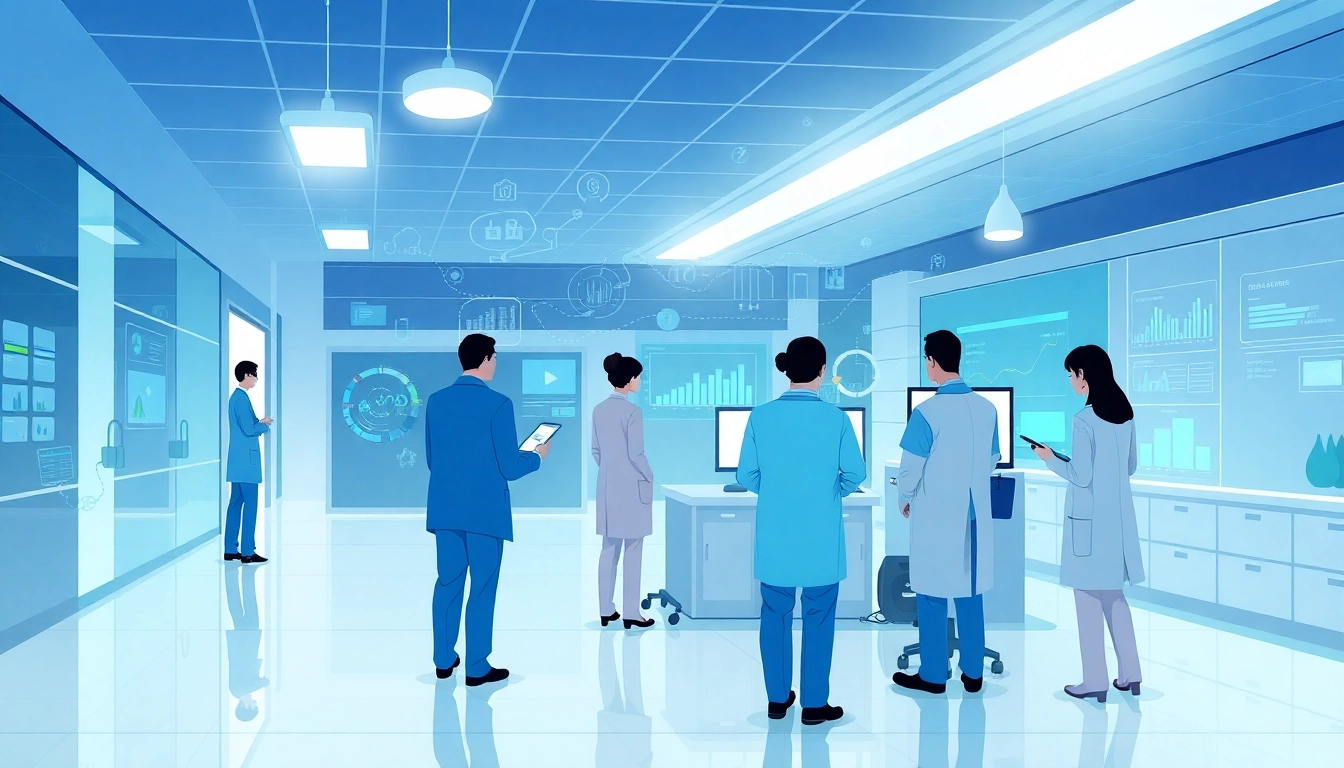Understanding Informatics in Healthcare
In the increasingly complex world of healthcare, the integration of data, technology, and patient care is more vital than ever. As systems and methodologies evolve, healthcare informatics emerges as a pivotal discipline. It concerns the role of data and information technology in healthcare, transforming raw data into actionable insights that significantly improve patient care and streamlining operations. For those looking to delve deeper into informatics, resources such as www.informaticsview.com provide valuable information and insights into this dynamic field.
What is Healthcare Informatics?
Healthcare informatics can be defined as the interdisciplinary study that focuses on the design, development, implementation, and evaluation of technology-based innovations in healthcare services. It combines various fields, including information technology, data science, and healthcare management, to facilitate better health outcomes. Its goal is to leverage information and communication technologies to enhance the delivery of healthcare services.
At its core, healthcare informatics affects every aspect of patient care—from the administration of medication to the management of health records. The informatics field is designed to improve decision-making across healthcare systems, directly impacting patient safety and quality of care. Moreover, the integration of informatics can lead to improved communication among healthcare professionals, which is essential for achieving health objectives.
The Importance of Data in Healthcare
Data is often referred to as the lifeblood of informatics. In healthcare, data comes from various sources, including electronic health records (EHRs), patient surveys, medical imaging systems, and clinical trials. Advanced techniques in data analysis help healthcare professionals make informed decisions that enhance treatment protocols, recipe development for new medications, and tracking of disease outbreaks.
Furthermore, data helps healthcare organizations identify trends that can improve service delivery and patient outcomes. For instance, tracking the frequency of certain diseases allows health authorities to prepare better public health responses and allocate resources more effectively. With big data analytics, healthcare providers can also tailor treatments and preventive strategies to individual patient needs, leading to personalized healthcare.
Key Technologies Affecting Healthcare Informatics
Several technologies play a crucial role in healthcare informatics, enhancing how data is captured, stored, and utilized. Some key technologies include:
- Electronic Health Records (EHRs): Integral to modern healthcare, EHRs enable seamless sharing of patient data among providers, facilitating informed decision-making and enhancing continuity of care.
- Telemedicine: This innovative approach allows healthcare providers to deliver care remotely, improving access to medical services, especially in rural areas.
- Wearable Technology: Devices like smartwatches and health-monitoring wearables provide real-time health data, which can be monitored by healthcare professionals to proactively manage patient health.
- Artificial Intelligence (AI): AI applications in healthcare enhance diagnostic accuracy, treatment recommendations, and operational efficiency through predictive analytics and machine learning.
- Health Information Exchange (HIE): This system allows different healthcare organizations to share patient data securely, improving the transparency and efficiency of patient care.
Applications of Informatics in Patient Care
The applications of informatics are vast and diverse, ultimately aiming to enhance the quality of patient care. Some prominent applications include:
Electronic Health Records (EHR)
EHR systems are a fundamental component of healthcare informatics. They store patient data, including medical histories, medications, allergies, immunization status, lab test results, and radiology images. The use of EHRs enables healthcare providers to access a comprehensive view of patient health, reducing the likelihood of errors and improving treatment efficacy.
By consolidating all patient information into a single digital record, EHRs facilitate better coordination among specialists, streamline workflows, and enhance communication between patients and providers. Moreover, EHR systems are often equipped with clinical decision support tools that provide evidence-based recommendations to clinicians, leading to informed decisions in real time.
Clinical Decision Support Systems (CDSS)
CDSS are sophisticated tools designed to assist healthcare professionals in making clinical decisions. They analyze patient data and provide recommendations based on clinical guidelines and best practices. Such systems enhance the decision-making process by providing alerts and reminders about potential issues, such as drug interactions or deviations from treatment protocols.
For example, if a physician plans to prescribe a medication that could adversely affect a patient due to an allergy, the CDSS would alert the healthcare provider, prompting a reassessment of the treatment plan. This capability not only enhances patient safety but also supports clinicians in delivering quality care efficiently.
Telemedicine Innovations
Telemedicine has revolutionized how healthcare is delivered, breaking down geographical barriers and allowing for remote consultations and monitoring. Patients can now consult with healthcare providers via video calls, reducing the need for in-person visits, particularly for follow-ups and non-emergency consultations.
This shift to remote care has broadened access to healthcare services, particularly for those with mobility issues or those living in rural areas where specialists may not be readily available. Moreover, it facilitates quick decision-making and accelerates the treatment process, as patients can receive advice and prescriptions within hours instead of days.
Implementing Informatics Solutions
Successfully implementing informatics solutions requires careful planning, proper tools, and adequate training for all healthcare staff. Here are the essential steps:
Choosing the Right Informatics Tools
Selection of appropriate informatics tools is critical for the successful integration of technology into healthcare practice. When assessing tools, healthcare organizations should consider their specific needs, budget constraints, and the interoperability of the systems with existing technologies. Examples of key criteria include:
- Usability: Tools should be user-friendly to facilitate quick adoption by healthcare professionals.
- Interoperability: Ensuring compatibility between different systems enhances data sharing and communication.
- Scalability: The solution should accommodate future growth and technological advancements.
- Support: Reliable customer support is essential for prompt resolution of technical issues.
Steps for Successful Integration
Integrating informatics solutions into healthcare settings requires a structured approach. Here are critical steps for successful implementation:
- Assessment of Current Systems: Evaluate existing systems and identify gaps that informatics solutions can fill.
- Stakeholder Engagement: Involve all relevant parties, including healthcare providers, IT specialists, and administrative staff, in the planning process.
- Training: Ensure comprehensive training for all staff members to maximize the effectiveness of the new system.
- Pilot Testing: Conduct pilot tests to identify potential issues before full-scale implementation.
- Monitoring and Evaluation: Continuously monitor the implementation process and evaluate performance metrics to ensure the system effectively improves patient care.
Training Staff for Informatic Practices
Training plays a vital role in the successful implementation of informatics systems. Staff should be well-versed in how to use new tools effectively to harness their full potential. Training should be comprehensive and ongoing, incorporating various learning methods, including:
- Workshops and Seminars: Focused training sessions to educate staff about new technologies and procedures.
- Online Tutorials and Resources: E-learning platforms allow staff to learn at their own pace and revisit materials as needed.
- Peer-to-Peer Mentoring: Experienced users can mentor newer staff, facilitating knowledge sharing and building confidence in using the systems.
Measuring the Impact of Informatics
To evaluate the effectiveness of informatics solutions, it is essential to measure their impact on healthcare delivery. Measurement can be achieved through the identification of clear performance indicators and case studies demonstrating successful implementations.
Key Performance Indicators (KPIs) for Informatics
KPIs provide measurable values that demonstrate how effectively a healthcare organization is achieving key business objectives. Common KPIs in healthcare informatics include:
- Patient Satisfaction Scores: Metrics reflecting patients’ experiences with care delivery, indicating system efficacy.
- Clinical Outcomes: Improvements in health outcomes (e.g., reduced readmission rates) following the implementation of informatics systems.
- Operational Efficiency: Metrics that assess time savings in patient management and reduced operational costs.
- Data Accuracy: The degree to which patient data is recorded accurately, impacting clinical decisions.
Case Studies of Successful Informatics Implementation
Highlighting successful case studies can provide real-world examples of best practices in informatics implementation. For instance, a hospital may have integrated a new EHR system that improved data sharing and patient safety, resulting in a measurable reduction in medication errors by 30% over six months. Such outcomes serve as evidence of the effectiveness of informatics investments and guide other organizations in planning their strategies.
Challenges and Solutions in Measurement
While measuring the impact of informatics is crucial, challenges often arise. These include data privacy concerns, difficulty in tracking certain metrics, and resistance from staff. Solutions for overcoming these obstacles include:
- Ensuring Compliance with Regulations: Staying informed about regulations like HIPAA to protect patient data is essential for gaining trust in data usage.
- Using Robust Analytical Tools: Implementing advanced data analytics tools can streamline the measurement process and simplify tracking.
- Engaging Staff in the Process: Fostering a supportive culture around informatics initiatives can encourage staff participation and acceptance of measurement practices.
The Future of Healthcare Informatics
As technology evolves, so does the field of healthcare informatics. Innovations continue to emerge that have the potential to reshape patient care significantly. Here are some trends shaping the future of healthcare informatics:
Emerging Trends in Health Informatics
The growth of telehealth, the expansion of population health management, and the increasing focus on patient-centered care are vital trends in health informatics. These developments point toward a transformation in how healthcare is delivered, emphasizing proactive care and preventive measures rather than reactive treatments.
Moreover, patient engagement technology is paving the way for more informed patients who actively participate in their care decisions. The introduction of apps and online platforms allows patients to access their health information, schedule appointments, and communicate with their healthcare providers seamlessly.
AI and Machine Learning Applications
AI and machine learning are set to revolutionize healthcare informatics further. These technologies can analyze vast datasets quickly and identify patterns that may not be readily apparent to human analysts. Examples of applications include:
- Predictive Analytics: AI can analyze historical healthcare data to predict patient outcomes and improve treatment plans.
- Natural Language Processing (NLP): This allows for the extraction of useful information from unstructured data sources, such as clinical notes and patient comments.
- Robotic Process Automation (RPA): RPA can help automate administrative tasks, reducing the burden on healthcare staff and allowing them to focus on patient care.
Policy and Ethical Considerations
Alongside the technological advancements, there are ethical considerations in healthcare informatics that cannot be ignored. Issues such as data privacy, security, and ethical data usage are prominent as patient data becomes increasingly digital. Organizations must adhere to strict compliance regulations while also fostering an ethical culture that prioritizes patient trust.
The role of policy is critical in governing how informatics is applied. Health informatics professionals should advocate for policies that promote the responsible use of technology and protect patient rights while maximizing the benefits of data-driven healthcare.



